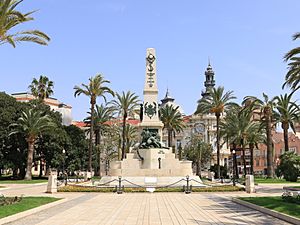Monument to the Heroes of Cavite and Santiago de Cuba facts for kids
| Héroes de Cavite y Santiago de Cuba | |
 |
|
| Coordinates | 37°35′53″N 0°59′09″W / 37.598193°N 0.985786°W |
|---|---|
| Location | Plaza Héroes de Cavite, Cartagena, Spain |
| Designer | Julio González-Pola |
| Material | Stone, bronze |
| Height | 15 m |
| Opening date | 9 November 1923 |
| Dedicated to | The heroic role of the Montojo and Cervera naval squadrons during the 1898 Spanish–American War |
The Monument to the Heroes of Cavite and Santiago de Cuba (in Spanish: Monumento a los Héroes de Cavite y Santiago de Cuba) is a special monument and a war memorial located in Cartagena, Spain. It was built to remember the brave actions of the naval groups led by Patricio Montojo and Pascual Cervera. These groups played a big part in the Spanish-American War of 1898.
Contents
Building the Monument
After World War I ended, a captain named Francisco Anaya Ruiz suggested building this monument in 1919. It was meant to honor Spanish soldiers who fought in the Spanish-American War.
People helped pay for it by donating money. Important people like King Alfonso XIII and General Miguel Primo de Rivera also contributed. When enough money was raised, Julio González-Pola was chosen to design it. The committee decided to build it in Cartagena instead of Cádiz. The monument was finished in August 1923.
Unveiling Ceremony
The monument was officially opened on November 9, 1923. Many important people attended the ceremony. These included King Alfonso XIII, General Miguel Primo de Rivera (who was then a dictator), and the US Ambassador Alexander Pollock Moore.
The monument was built to honor "the heroic behavior of the Montojo and Cervera squadrons." These groups fought in the naval battles of Cavite and Santiago de Cuba. These battles were very important during the Spanish-American War.
What the Monument Looks Like
The monument stands about 15 meters (nearly 50 feet) tall. It is made of stone and has a tall, pointed pillar called an obelisk in the middle.
Sculptures and Details
Several bronze sculptures are part of the monument. There are two figures that represent Glory. You can also see the coat of arms of Spain. Two other groups of sculptures show 'Heroism' and Patria (which means "homeland"). There are also decorations that look like things used on ships.
On the front of the obelisk, it says in small capital letters: "a los heroicos marinos de cavite y santiago de cuba, 1898". This means "To the Heroic Sailors of Cavite and Santiago de Cuba, 1898." On the back, it says: "honor a las escuadras de cervera y montojo", meaning "Honor to the Cervera and Montojo squadrons." The sides of the monument list the soldiers who were lost in both battles.
In 2020, people started the process to declare this monument a Bien de Interés Cultural. This means it would be recognized as an important cultural heritage site.
Images for kids
See also
 In Spanish: Héroes de Cavite para niños
In Spanish: Héroes de Cavite para niños




